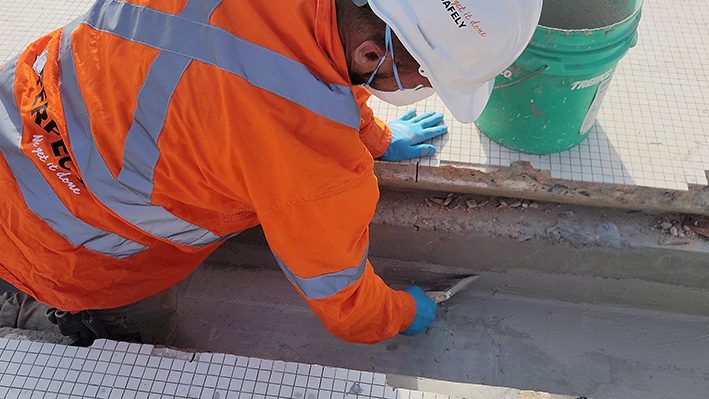Waterproofing is crucial in protecting the building and preserving its structural integrity. Poor waterproofing can fail, leading to cracks, mould issues, and structural defects like concrete cancers. It can cause safety issues caused by structural damage eventually rendering the place uninhabitable as well as significantly reduce the value of the property. Although waterproofing accounts for only 2-3% of a building’s total costs, waterproofing defects can end up causing 80% of a building’s defects. Fortunately, if detected early, remediating waterproofing issues is significantly inexpensive compared to the potential damages it can cause.
Failure of waterproofing can cause a plethora of issues such as leaks, concrete cancer, cracks and so on. The most common waterproofing problems include:
Problems with flat roofs
The refurbishment of a failed flat roof is the most common waterproofing problem. Taking all the variables into consideration when specifying a waterproofing solution is not an easy process. Water ingress due to failure of the roof components or due to the shortcomings of the roof construction can have a dramatic effect on the building occupier, resulting in water ingress and the loss of thermal performance of any existing insulation material. In addition, the financial burden associated with the roofing works necessary to reinstate the integrity of the roof waterproofing can be significant. Diagnosis of the problem may not be straightforward. Water could be collecting within the roofing layers due to several reasons such as, poor perimeter detailing or inadequate detailing around penetrations, failure of upturn or the outermost weathering layer and so on.
Concrete Cancers
Concrete cancer can lead to severe structural damage. Because concrete is porous, it can absorb water and salt air very easily, which corrodes the steel inside. Concrete in buildings is typically reinforced with steel bars or mesh, and exposure to air and water can lead to corrosion of the steel.
This process is what gives a structure concrete cancer. Concrete cancer is when concrete absorbs water and salt air which rusts the steel within. When steel corrodes, it expands. When it expands, it cracks the concrete.
The cracking accelerates the concrete cancer process by exposing more of the steel, which significantly weakens the building. It is called cancer because if left untreated the damage will grow further, faster, and be more severe.
Problems caused by the levels above
In multilevel buildings, the higher floors can cause issues when it comes to waterproofing failure. Top-floor levels can experience waterproofing problems from rainwater puddles forming on the roof. Flat roofs can especially collect excessive rain that leads to leaks and eventually damage the structure of the building. Defective plumbing can also lead to waterproofing failure.
Cracks and Leaks
Leaking water can damage furniture, carpeting, and other items in addition to the building’s structure. Incorrect installation methodology can lead to leakage issues. Correct installation is key when it comes to waterproofing. Many leakage problems are caused by poor waterproofing, which can result in moisture. If the waterproofing is done incorrectly, the building can degrade much quicker due to the moisture build up. Balconies and windows are especially prone to waterproofing issues and so, waterproofing of these areas need to be done with extra care. Incorrect installation also includes using the wrong product and insufficient substrate preparation which means poor preparation before the waterproofing membrane is applied.
It is important to use a complete waterproofing system that includes a sheet membrane with all the ancillaries. It is also important to consider how flexible the membrane is to allow building movements and how resistant it is to the UV, chemicals, harsh salt air and in the case of green applications, to root penetrations.
Remedial waterproofing
Ongoing maintenance in the form of checks and remedial waterproofing enables you to catch problems early and avoid significant issues like concrete cancer. Even tiny leaks and cracks can escalate unexpectedly fast leading to major problems if not treated right away. Maintaining existing seals on your windows, doors, and wall systems and regularly checking balconies, roofs, windows, cracks, and leaks is highly recommended. Taking a proactive approach to maintenance can significantly minimise the risk of it developing into a major problem.
Your maintenance checks ideally include a review of the drainage efficiency of roof areas, the plumbing system, and areas like windows that are directly exposed to water and the elements. Remember, a thorough inspection of the building is important for catching cracks and leaks as early as possible. You’ll want to check key areas like roofs, and balconies as well as living and working spaces even if they’re situated well away from sources of water.
Commercial roofs should be inspected at least once every six months, and an inspection should look at the vents, drains, and other areas of the roof where water could seep through to the building. An inspection should look for stains as well as cracks and leaks.
Check your drains, plumbing, and irrigation as part of your regular maintenance. These areas of your building or site are more likely to have leaks that are hard to spot, so do a comprehensive review of these areas on a regular basis. Even the smallest leaks warrant your attention, and with some quick action and remedial waterproofing, you can save money and preserve your building’s value.
Why Perfect Remediation?
Your best chance of obtaining a great remedial-waterproofing outcome is with remediation experts. Perfect Remediation can assist with the right products for the area, and they use the correct methodology to apply the waterproofing membrane. Waterproofing failure can have a drastic impact on the safety and value of a building. Poor workmanship, including using the wrong product and applying the membrane incorrectly, is often behind waterproofing failure. Regular checks and timely remedial waterproofing, however, can help you stop small leaks and issues turning into major problems.
For more information on our services, take a look at our webpage or request a free quote.
contact us today
